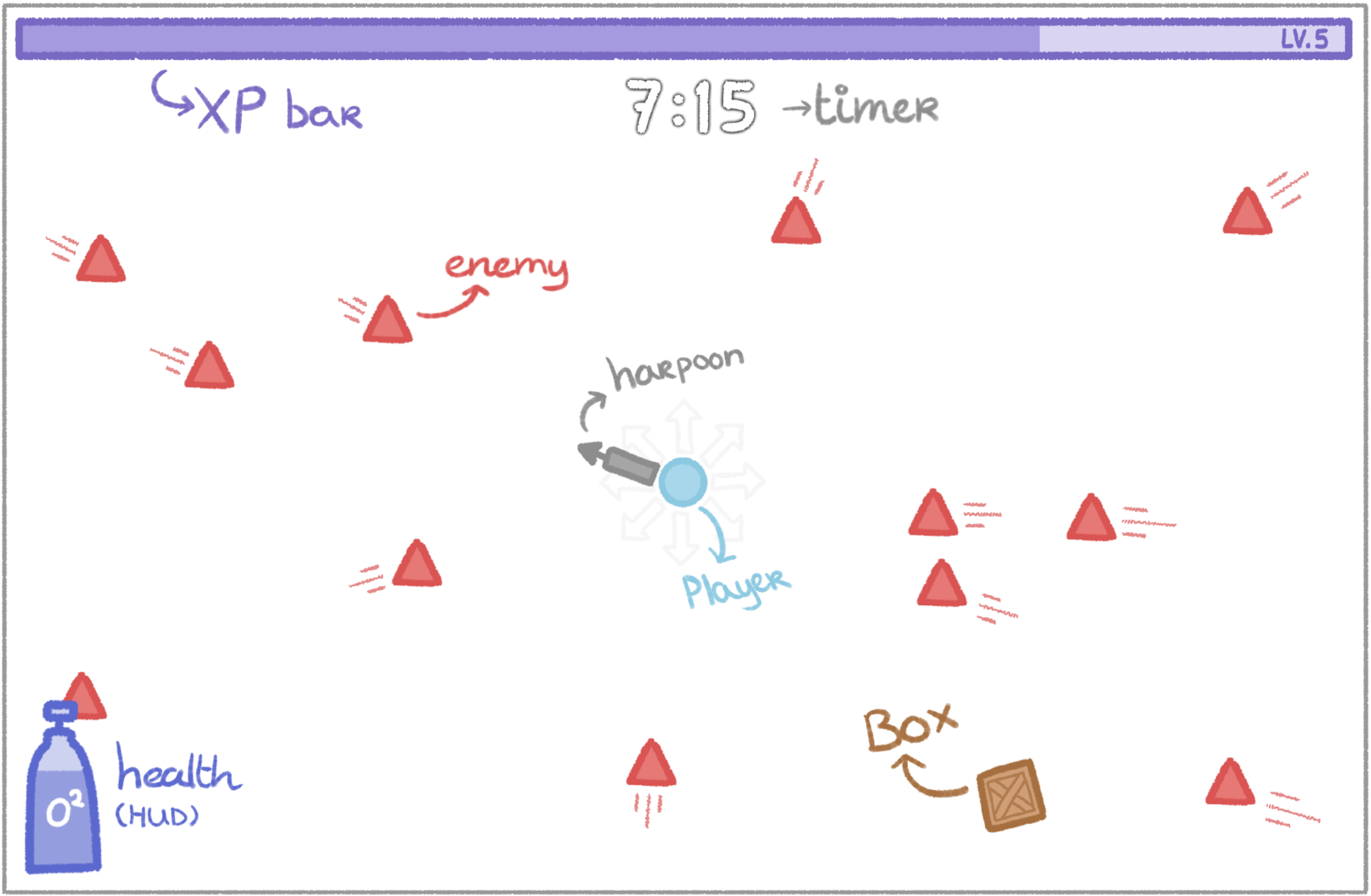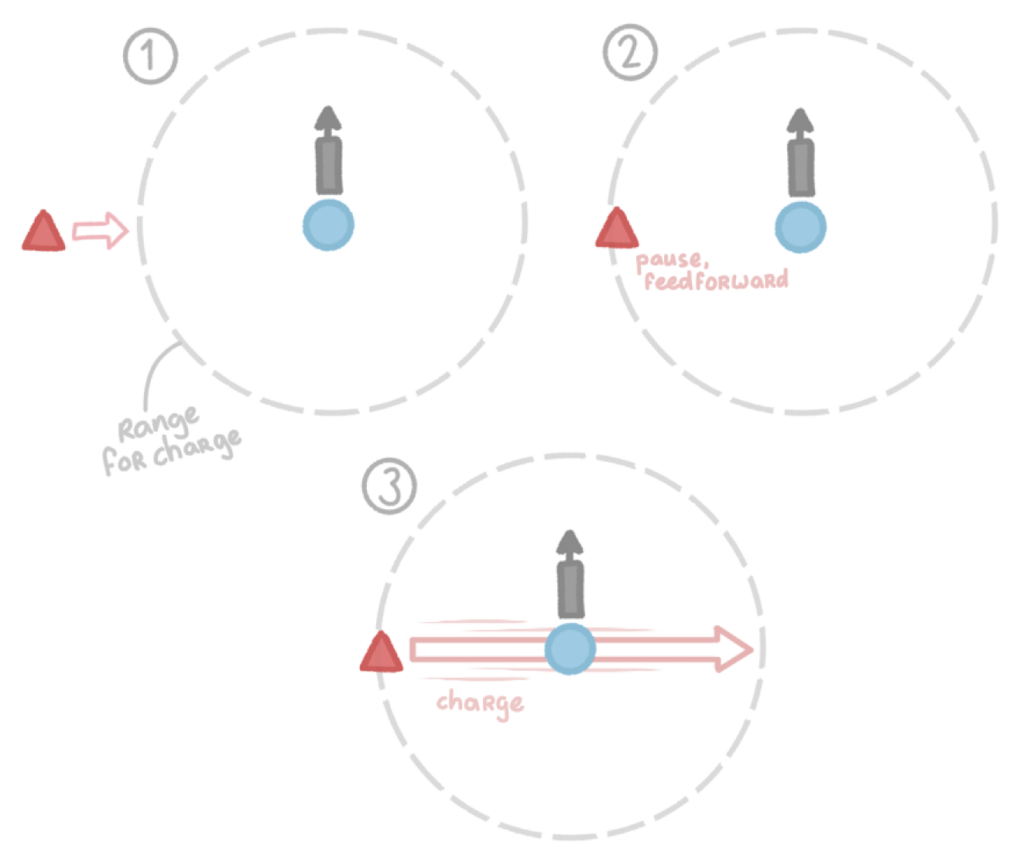HARPOON HELL
Harpoon Hell is a chaotic twin-stick shooter inspired by Vampire Survivors and Dave the Diver, where you play as a diver hunting waves of marine predators with your trusty harpoon. Get stronger by killing fish, leveling up, and choosing upgrades.

Solo

7 Weeks

UE5

CONTRIBUTIONS
The Game Mode
Design
The game has a survival game mode, where the goal is to stay alive for as long as possible or until hitting the ten-minute mark, at which the game ends.
Enemies spawn in waves that gradually increase in difficulty. A wave gets spawned over the span of a minute, to ensure that a wave remains challenging, rather than starting out very challenging and becoming easier the more enemies the player kills.
While fending off waves of enemies, players must also manage their oxygen levels by seeking out oxygen crates, adding an extra layer of tension and chaos, urging the player to keep moving at all times.

The Weapon
Design
The harpoon weapon adds a unique twist to combat within the underwater setting. While it functions like a traditional gun, its limited range encourages players to engage more closely with enemies, introducing a strategic element to gameplay. The design keeps things simple to allow for an upgrade system that can enhance the harpoon’s capabilities without overwhelming players with complex mechanics.
Developing the Upgrade System
Design
The goal was to build an upgrade system that gives players a rewarding power curve, strategic choices, and a sense of progression with each level-up. It also needed to be easily expandable, allowing new upgrades to be added without hassle.
With each level-up, players choose from three randomized upgrades that enhance specific abilities, from attack speed and harpoon piercing to movement speed and oxygen capacity. This structure allows players to experiment with different playstyles and makes each run unique, boosting replayability.
Implementation
To ensure easy scalability, I structured the upgrade data using a DataTable of structs, storing attributes like upgrade name, description, icon, and starting level. This setup streamlines the process of adding new upgrades—new rows added to the DataTable automatically appear in the level-up widget without extra changes. Functionality of upgrades is handled in the player blueprint, utilizing a Switch on String node to direct the appropriate event for each upgrade. This design choice makes the upgrade logic modular and easy to extend, allowing for quick adjustments and additions in the future. Additionally, I created a Debug Menu for the upgrades to simplify testing.
The Dynamic Enemy Spawn System
Design
Inspired by Vampire Survivors, the goal was to make players feel surrounded, ensuring survival isn’t possible by simply running away. This creates a challenging and chaotic player experience experience where constant movement is crucial.
Testing quickly revealed that fixed spawners failed to achieve this, as players could easily evade and kite enemies. Observing Vampire Survivors, I concluded that spawners must follow the player’s viewport, continuously spawning enemies around the screen’s edges. Additionally, to prevent players from outrunning slower enemies too far, enemies that have left the viewport for too long must respawn.
Implementation
Eight spawn points are positioned just outside the viewport’s edges and update dynamically to stay aligned with it. The Game Mode uses wave data from a datatable to spawn enemies at random spawn points over the course of a minute, adhering to specified intervals, spawn counts, and enemy types. When an enemy leaves the viewport and does not come in view again within a certain emount of time, it gets respawned.
The Shark Enemy

Design
Inspired by the shark enemy in Dave the Diver, this enemy charges towards and through the player at a fast pace when it is within a certain distance of the player. This forced the player to think and act fast, and encourages the player to keep a distance and improve their weapon using upgrades that, for example, increase the range of the harpoon.
Implementation
This enemy was made using Unreal Engine’s behaviour trees. When not in range, the shark simply moves towards the player using the MoveTo task, but when it detects that the player is within range, it waits for a moment before firing a custom task that handles the charging.





